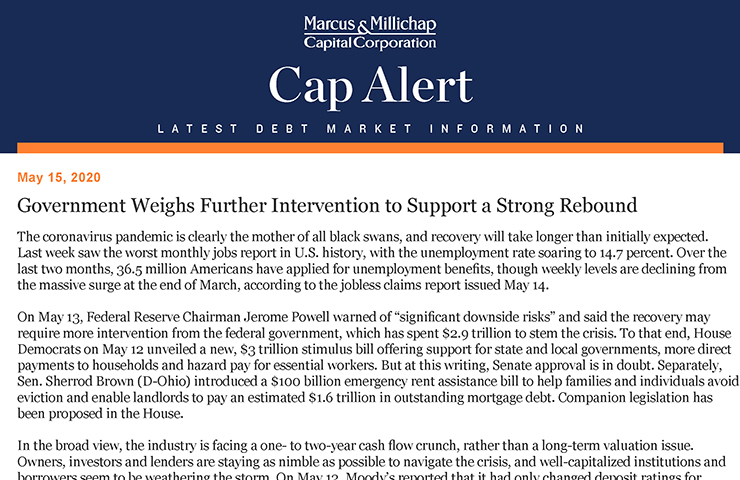
May 15, 2020 – The coronavirus pandemic is clearly the mother of all black swans, and recovery will take longer than initially expected. Last week saw the worst monthly jobs report in U.S. history, with the unemployment rate soaring to 14.7 percent. Over the last two months, 36.5 million Americans have applied for unemployment benefits, though weekly levels are declining from the massive surge at the end of March, according to the jobless claims report issued May 14.
On May 13, Federal Reserve Chairman Jerome Powell warned of “significant downside risks” and said the recovery may require more intervention from the federal government, which has spent $2.9 trillion to stem the crisis. To that end, House Democrats on May 12 unveiled a new, $3 trillion stimulus bill offering support for state and local governments, more direct payments to households and hazard pay for essential workers. But at this writing, Senate approval is in doubt. Separately, Sen. Sherrod Brown (D-Ohio) introduced a $100 billion emergency rent assistance bill to help families and individuals avoid eviction and enable landlords to pay an estimated $1.6 trillion in outstanding mortgage debt. Companion legislation has been proposed in the House.
In the broad view, the industry is facing a one- to two-year cash flow crunch, rather than a long-term valuation issue. Owners, investors and lenders are staying as nimble as possible to navigate the crisis, and well-capitalized institutions and borrowers seem to be weathering the storm. On May 12, Moody’s reported that it had only changed deposit ratings for 5 percent of banks in its coverage area, and only 12 percent had been assigned a negative outlook or placed on review for a downgrade. “The shock has not led to immediate or wholesale changes in the underlying credit strength of banks,” the rating agency noted.
Meanwhile, many borrowers are continuing to pay their mortgages, while others are being given 90-day deferrals and an opportunity to seek rescue capital. Some lenders are offering modifications in exchange for more recourse or partial payments. Insurance companies and institutions doing balance sheet lending may have more leeway to allow modifications that CMBS does not offer. The CARES Act gave banks the ability to modify loans without classifying them as troubled-debt restructurings; regulators have extended that to life companies, which can now modify loans without triggering risk-based capital rules, at least through the end of the second quarter. Meanwhile, some special servicers are doing modifications through the performing loan consent process to help minimize administrative fees.
Senior debt will be available but at much lower loan-to-value ratios, creating room for mezzanine and preferred debt, but at higher rates. Deep-pocketed investors are looking for opportunities to get involved in the debt stack but on generous terms, as well as acquiring assets at a discount. With interest rates expected to remain lower for a longer period, many market participants are looking to lock in long-term debt.
Meanwhile, some business owners also got a boost this week when the Small Business Administration (SBA) said it will provide safe harbor for companies that received Paycheck Protection Program loans under $2 million. Until this week, all PPP borrowers had to certify that the loan was necessary to support ongoing operations. Now those who borrowed less than $2 million will be considered to have made the required certification in good faith. Struggling businesses can focus their time and energy on rehiring workers and positioning their enterprises to ride out the storm, rather than SBA compliance paperwork.
Moody’s expects a modest recovery in the second half, depending the length and severity of the pandemic, and on that front, there has been positive news. On May 12, New York state and New York City both reported their fifth consecutive day of decreases in new cases, and their lowest daily incidence count since March 17, according to Johns Hopkins. In addition, the pace and increase in mortgage forbearance requests has begun to slow, with the total rising to 7.91 percent of all portfolio loans, up from 7.54 percent a week earlier, according to Mortgage Bankers Association survey. Separately, The National Multifamily Housing Council found 80.2 percent of apartment households made a full or partial rent payment by May 6, up from 78 percent a month earlier, in its survey of 11.4 million units of professionally managed apartment units across the country.